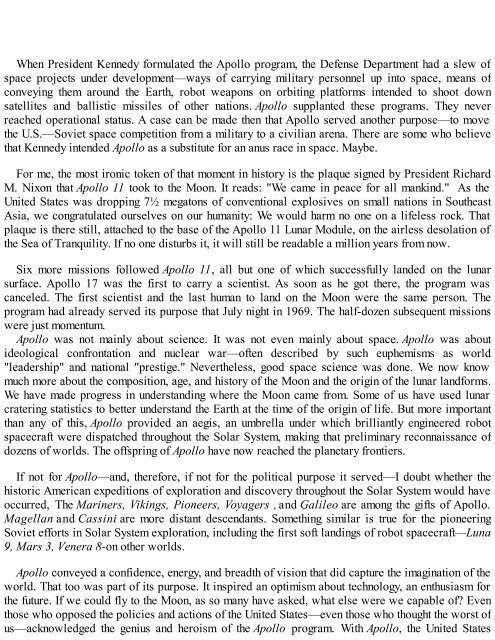Pale Blue Dot ( PDFDrive.com ) (1)
Create successful ePaper yourself
Turn your PDF publications into a flip-book with our unique Google optimized e-Paper software.
When President Kennedy formulated the Apollo program, the Defense Department had a slew of<br />
space projects under development—ways of carrying military personnel up into space, means of<br />
conveying them around the Earth, robot weapons on orbiting platforms intended to shoot down<br />
satellites and ballistic missiles of other nations. Apollo supplanted these programs. They never<br />
reached operational status. A case can be made then that Apollo served another purpose—to move<br />
the U.S.—Soviet space <strong>com</strong>petition from a military to a civilian arena. There are some who believe<br />
that Kennedy intended Apollo as a substitute for an anus race in space. Maybe.<br />
For me, the most ironic token of that moment in history is the plaque signed by President Richard<br />
M. Nixon that Apollo 11 took to the Moon. It reads: "We came in peace for all mankind." As the<br />
United States was dropping 7½ megatons of conventional explosives on small nations in Southeast<br />
Asia, we congratulated ourselves on our humanity: We would harm no one on a lifeless rock. That<br />
plaque is there still, attached to the base of the Apollo 11 Lunar Module, on the airless desolation of<br />
the Sea of Tranquility. If no one disturbs it, it will still be readable a million years from now.<br />
Six more missions followed Apollo 11, all but one of which successfully landed on the lunar<br />
surface. Apollo 17 was the first to carry a scientist. As soon as he got there, the program was<br />
canceled. The first scientist and the last human to land on the Moon were the same person. The<br />
program had already served its purpose that July night in 1969. The half-dozen subsequent missions<br />
were just momentum.<br />
Apollo was not mainly about science. It was not even mainly about space. Apollo was about<br />
ideological confrontation and nuclear war—often described by such euphemisms as world<br />
"leadership" and national "prestige." Nevertheless, good space science was done. We now know<br />
much more about the <strong>com</strong>position, age, and history of the Moon and the origin of the lunar landforms.<br />
We have made progress in understanding where the Moon came from. Some of us have used lunar<br />
cratering statistics to better understand the Earth at the time of the origin of life. But more important<br />
than any of this, Apollo provided an aegis, an umbrella under which brilliantly engineered robot<br />
spacecraft were dispatched throughout the Solar System, making that preliminary reconnaissance of<br />
dozens of worlds. The offspring of Apollo have now reached the planetary frontiers.<br />
If not for Apollo—and, therefore, if not for the political purpose it served—I doubt whether the<br />
historic American expeditions of exploration and discovery throughout the Solar System would have<br />
occurred, The Mariners, Vikings, Pioneers, Voyagers , and Galileo are among the gifts of Apollo.<br />
Magellan and Cassini are more distant descendants. Something similar is true for the pioneering<br />
Soviet efforts in Solar System exploration, including the first soft landings of robot spacecraft—Luna<br />
9, Mars 3, Venera 8-on other worlds.<br />
Apollo conveyed a confidence, energy, and breadth of vision that did capture the imagination of the<br />
world. That too was part of its purpose. It inspired an optimism about technology, an enthusiasm for<br />
the future. If we could fly to the Moon, as so many have asked, what else were we capable of? Even<br />
those who opposed the policies and actions of the United States—even those who thought the worst of<br />
us—acknowledged the genius and heroism of the Apollo program. With Apollo, the United States


